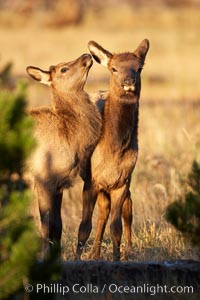
Two young elk at play, autumn, fall.
Species: Elk, Cervus canadensis
Location: Yellowstone National Park, Wyoming
Image ID: 19738
Species: Elk, Cervus canadensis
Location: Yellowstone National Park, Wyoming
Image ID: 19738
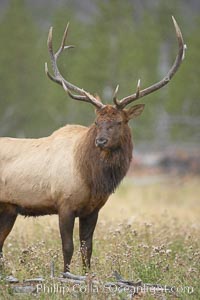
Elk, bull elk, adult male elk with large set of antlers. By September, this bull elk's antlers have reached their full size and the velvet has fallen off. This bull elk has sparred with other bulls for access to herds of females in estrous and ready to mate.
Species: Elk, Cervus canadensis
Location: Yellowstone National Park, Wyoming
Image ID: 19740
Species: Elk, Cervus canadensis
Location: Yellowstone National Park, Wyoming
Image ID: 19740
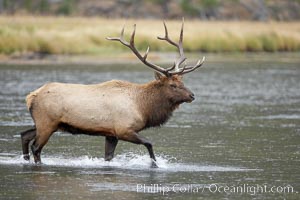
Male elk bugling during the fall rut. Large male elk are known as bulls. Male elk have large antlers which are shed each year. Male elk engage in competitive mating behaviors during the rut, including posturing, antler wrestling and bugling, a loud series of screams which is intended to establish dominance over other males and attract females.
Species: Elk, Cervus canadensis
Location: Madison River, Yellowstone National Park, Wyoming
Image ID: 19741
Species: Elk, Cervus canadensis
Location: Madison River, Yellowstone National Park, Wyoming
Image ID: 19741
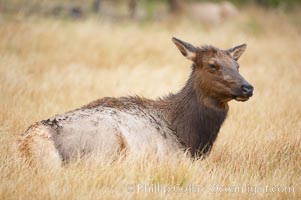
Elk, adult female, rests in grass meadow.
Species: Elk, Cervus canadensis
Location: Yellowstone National Park, Wyoming
Image ID: 19742
Species: Elk, Cervus canadensis
Location: Yellowstone National Park, Wyoming
Image ID: 19742
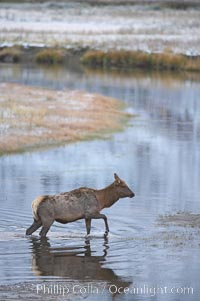
Male elk bugling during the fall rut. Large male elk are known as bulls. Male elk have large antlers which are shed each year. Male elk engage in competitive mating behaviors during the rut, including posturing, antler wrestling and bugling, a loud series of screams which is intended to establish dominance over other males and attract females.
Species: Elk, Cervus canadensis
Location: Madison River, Yellowstone National Park, Wyoming
Image ID: 19743
Species: Elk, Cervus canadensis
Location: Madison River, Yellowstone National Park, Wyoming
Image ID: 19743
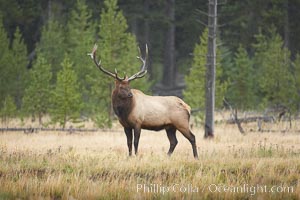
Elk, bull elk, adult male elk with large set of antlers. By September, this bull elk's antlers have reached their full size and the velvet has fallen off. This bull elk has sparred with other bulls for access to herds of females in estrous and ready to mate.
Species: Elk, Cervus canadensis
Location: Yellowstone National Park, Wyoming
Image ID: 19748
Species: Elk, Cervus canadensis
Location: Yellowstone National Park, Wyoming
Image ID: 19748
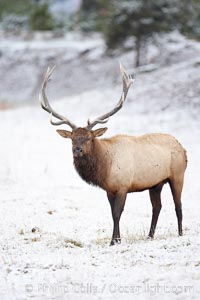
Large male elk (bull) in snow covered meadow near Madison River. Only male elk have antlers, which start growing in the spring and are shed each winter. The largest antlers may be 4 feet long and weigh up to 40 pounds. Antlers are made of bone which can grow up to one inch per day. While growing, the antlers are covered with and protected by a soft layer of highly vascularised skin known as velvet. The velvet is shed in the summer when the antlers have fully developed. Bull elk may have six or more tines on each antler, however the number of tines has little to do with the age or maturity of a particular animal.
Species: Elk, Cervus canadensis
Location: Yellowstone National Park, Wyoming
Image ID: 19751
Species: Elk, Cervus canadensis
Location: Yellowstone National Park, Wyoming
Image ID: 19751
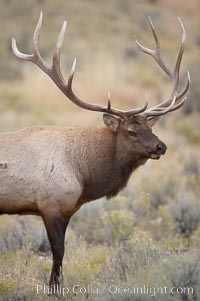
Bull elk in sage brush with large rack of antlers during the fall rut (mating season). This bull elk has sparred with other bulls to establish his harem of females with which he hopes to mate.
Species: Elk, Cervus canadensis
Location: Mammoth Hot Springs, Yellowstone National Park, Wyoming
Image ID: 19752
Species: Elk, Cervus canadensis
Location: Mammoth Hot Springs, Yellowstone National Park, Wyoming
Image ID: 19752
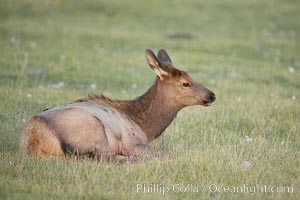
Elk, juvenile, rests in grass meadow.
Species: Elk, Cervus canadensis
Location: Yellowstone National Park, Wyoming
Image ID: 19753
Species: Elk, Cervus canadensis
Location: Yellowstone National Park, Wyoming
Image ID: 19753
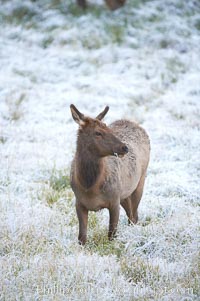
Female elk walks through grass meadow in early autumn snowfall.
Species: Elk, Cervus canadensis
Location: Yellowstone National Park, Wyoming
Image ID: 19754
Species: Elk, Cervus canadensis
Location: Yellowstone National Park, Wyoming
Image ID: 19754
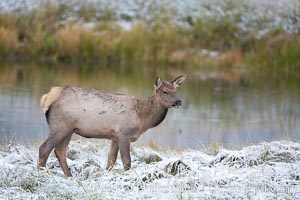
Male elk bugling during the fall rut. Large male elk are known as bulls. Male elk have large antlers which are shed each year. Male elk engage in competitive mating behaviors during the rut, including posturing, antler wrestling and bugling, a loud series of screams which is intended to establish dominance over other males and attract females.
Species: Elk, Cervus canadensis
Location: Madison River, Yellowstone National Park, Wyoming
Image ID: 19755
Species: Elk, Cervus canadensis
Location: Madison River, Yellowstone National Park, Wyoming
Image ID: 19755
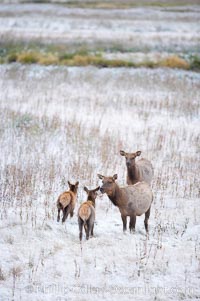
Female and young elk in early autumn snowfall.
Species: Elk, Cervus canadensis
Location: Yellowstone National Park, Wyoming
Image ID: 19756
Species: Elk, Cervus canadensis
Location: Yellowstone National Park, Wyoming
Image ID: 19756
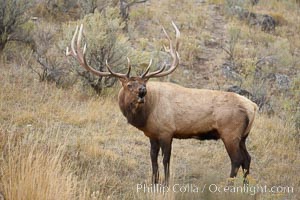
Male elk bugling during the fall rut. Large male elk are known as bulls. Male elk have large antlers which are shed each year. Male elk engage in competitive mating behaviors during the rut, including posturing, antler wrestling and bugling, a loud series of screams which is intended to establish dominance over other males and attract females.
Species: Elk, Cervus canadensis
Location: Mammoth Hot Springs, Yellowstone National Park, Wyoming
Image ID: 19757
Species: Elk, Cervus canadensis
Location: Mammoth Hot Springs, Yellowstone National Park, Wyoming
Image ID: 19757
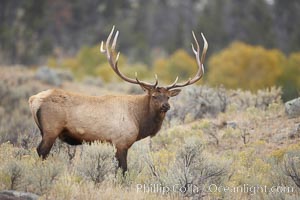
Bull elk in sage brush with large rack of antlers during the fall rut (mating season). This bull elk has sparred with other bulls to establish his harem of females with which he hopes to mate.
Species: Elk, Cervus canadensis
Location: Mammoth Hot Springs, Yellowstone National Park, Wyoming
Image ID: 19759
Species: Elk, Cervus canadensis
Location: Mammoth Hot Springs, Yellowstone National Park, Wyoming
Image ID: 19759
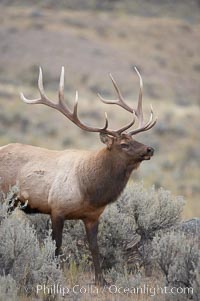
Bull elk in sage brush with large rack of antlers during the fall rut (mating season). This bull elk has sparred with other bulls to establish his harem of females with which he hopes to mate.
Species: Elk, Cervus canadensis
Location: Mammoth Hot Springs, Yellowstone National Park, Wyoming
Image ID: 19760
Species: Elk, Cervus canadensis
Location: Mammoth Hot Springs, Yellowstone National Park, Wyoming
Image ID: 19760
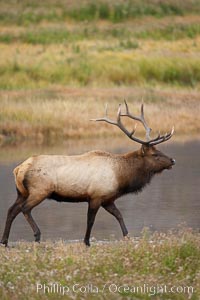
Male elk bugling during the fall rut. Large male elk are known as bulls. Male elk have large antlers which are shed each year. Male elk engage in competitive mating behaviors during the rut, including posturing, antler wrestling and bugling, a loud series of screams which is intended to establish dominance over other males and attract females.
Species: Elk, Cervus canadensis
Location: Madison River, Yellowstone National Park, Wyoming
Image ID: 19761
Species: Elk, Cervus canadensis
Location: Madison River, Yellowstone National Park, Wyoming
Image ID: 19761
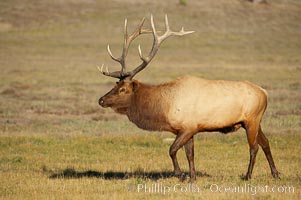
Elk, bull elk, adult male elk with large set of antlers. By September, this bull elk's antlers have reached their full size and the velvet has fallen off. This bull elk has sparred with other bulls for access to herds of females in estrous and ready to mate.
Species: Elk, Cervus canadensis
Location: Yellowstone National Park, Wyoming
Image ID: 19763
Species: Elk, Cervus canadensis
Location: Yellowstone National Park, Wyoming
Image ID: 19763
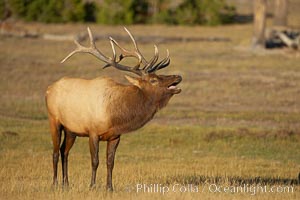
Male elk bugling during the fall rut. Large male elk are known as bulls. Male elk have large antlers which are shed each year. Male elk engage in competitive mating behaviors during the rut, including posturing, antler wrestling and bugling, a loud series of screams which is intended to establish dominance over other males and attract females.
Species: Elk, Cervus canadensis
Location: Yellowstone National Park, Wyoming
Image ID: 19764
Species: Elk, Cervus canadensis
Location: Yellowstone National Park, Wyoming
Image ID: 19764
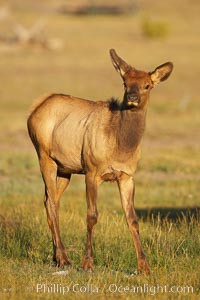
Juvenile elk in golden, late afternoon light, in meadow along Madison River, autumn.
Species: Elk, Cervus canadensis
Location: Yellowstone National Park, Wyoming
Image ID: 19765
Species: Elk, Cervus canadensis
Location: Yellowstone National Park, Wyoming
Image ID: 19765
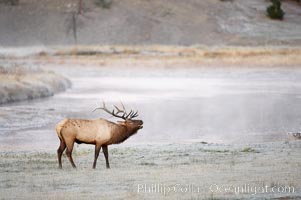
Male elk bugling during the fall rut. Large male elk are known as bulls. Male elk have large antlers which are shed each year. Male elk engage in competitive mating behaviors during the rut, including posturing, antler wrestling and bugling, a loud series of screams which is intended to establish dominance over other males and attract females.
Species: Elk, Cervus canadensis
Location: Madison River, Yellowstone National Park, Wyoming
Image ID: 19766
Species: Elk, Cervus canadensis
Location: Madison River, Yellowstone National Park, Wyoming
Image ID: 19766
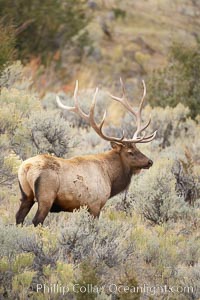
Bull elk in sage brush with large rack of antlers during the fall rut (mating season). This bull elk has sparred with other bulls to establish his harem of females with which he hopes to mate.
Species: Elk, Cervus canadensis
Location: Mammoth Hot Springs, Yellowstone National Park, Wyoming
Image ID: 19768
Species: Elk, Cervus canadensis
Location: Mammoth Hot Springs, Yellowstone National Park, Wyoming
Image ID: 19768
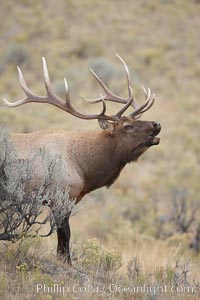
Male elk bugling during the fall rut. Large male elk are known as bulls. Male elk have large antlers which are shed each year. Male elk engage in competitive mating behaviors during the rut, including posturing, antler wrestling and bugling, a loud series of screams which is intended to establish dominance over other males and attract females.
Species: Elk, Cervus canadensis
Location: Mammoth Hot Springs, Yellowstone National Park, Wyoming
Image ID: 19769
Species: Elk, Cervus canadensis
Location: Mammoth Hot Springs, Yellowstone National Park, Wyoming
Image ID: 19769
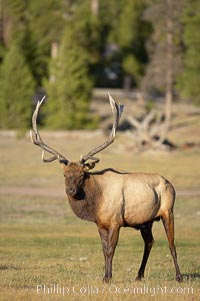
Elk, bull elk, adult male elk with large set of antlers. By September, this bull elk's antlers have reached their full size and the velvet has fallen off. This bull elk has sparred with other bulls for access to herds of females in estrous and ready to mate.
Species: Elk, Cervus canadensis
Location: Yellowstone National Park, Wyoming
Image ID: 19770
Species: Elk, Cervus canadensis
Location: Yellowstone National Park, Wyoming
Image ID: 19770
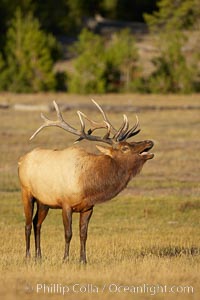
Male elk bugling during the fall rut. Large male elk are known as bulls. Male elk have large antlers which are shed each year. Male elk engage in competitive mating behaviors during the rut, including posturing, antler wrestling and bugling, a loud series of screams which is intended to establish dominance over other males and attract females.
Species: Elk, Cervus canadensis
Location: Yellowstone National Park, Wyoming
Image ID: 19771
Species: Elk, Cervus canadensis
Location: Yellowstone National Park, Wyoming
Image ID: 19771
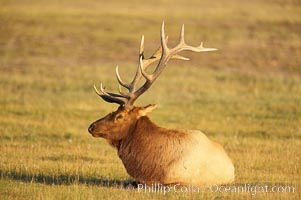
Elk, bull elk, adult male elk with large set of antlers. By September, this bull elk's antlers have reached their full size and the velvet has fallen off. This bull elk has sparred with other bulls for access to herds of females in estrous and ready to mate.
Species: Elk, Cervus canadensis
Location: Yellowstone National Park, Wyoming
Image ID: 19772
Species: Elk, Cervus canadensis
Location: Yellowstone National Park, Wyoming
Image ID: 19772
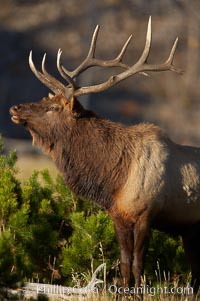
Elk, bull elk, adult male elk with large set of antlers. By September, this bull elk's antlers have reached their full size and the velvet has fallen off. This bull elk has sparred with other bulls for access to herds of females in estrous and ready to mate.
Species: Elk, Cervus canadensis
Location: Yellowstone National Park, Wyoming
Image ID: 19774
Species: Elk, Cervus canadensis
Location: Yellowstone National Park, Wyoming
Image ID: 19774
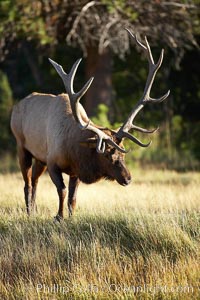
Elk, bull elk, adult male elk with large set of antlers. By September, this bull elk's antlers have reached their full size and the velvet has fallen off. This bull elk has sparred with other bulls for access to herds of females in estrous and ready to mate.
Species: Elk, Cervus canadensis
Location: Yellowstone National Park, Wyoming
Image ID: 19775
Species: Elk, Cervus canadensis
Location: Yellowstone National Park, Wyoming
Image ID: 19775
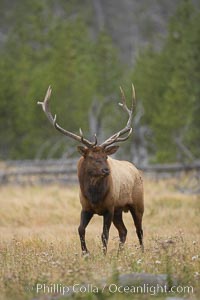
Elk, bull elk, adult male elk with large set of antlers. By September, this bull elk's antlers have reached their full size and the velvet has fallen off. This bull elk has sparred with other bulls for access to herds of females in estrous and ready to mate.
Species: Elk, Cervus canadensis
Location: Yellowstone National Park, Wyoming
Image ID: 19776
Species: Elk, Cervus canadensis
Location: Yellowstone National Park, Wyoming
Image ID: 19776
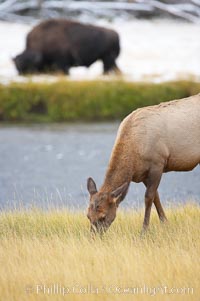
Male elk bugling during the fall rut. Large male elk are known as bulls. Male elk have large antlers which are shed each year. Male elk engage in competitive mating behaviors during the rut, including posturing, antler wrestling and bugling, a loud series of screams which is intended to establish dominance over other males and attract females.
Species: Elk, Bison bison, Cervus canadensis
Location: Madison River, Yellowstone National Park, Wyoming
Image ID: 19777
Species: Elk, Bison bison, Cervus canadensis
Location: Madison River, Yellowstone National Park, Wyoming
Image ID: 19777
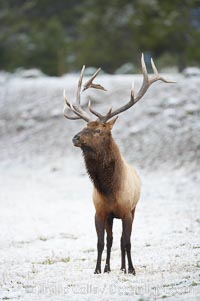
Large male elk (bull) in snow covered meadow near Madison River. Only male elk have antlers, which start growing in the spring and are shed each winter. The largest antlers may be 4 feet long and weigh up to 40 pounds. Antlers are made of bone which can grow up to one inch per day. While growing, the antlers are covered with and protected by a soft layer of highly vascularised skin known as velvet. The velvet is shed in the summer when the antlers have fully developed. Bull elk may have six or more tines on each antler, however the number of tines has little to do with the age or maturity of a particular animal.
Species: Elk, Cervus canadensis
Location: Yellowstone National Park, Wyoming
Image ID: 19778
Species: Elk, Cervus canadensis
Location: Yellowstone National Park, Wyoming
Image ID: 19778